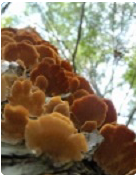Henry Pond Brook Preserve, Newtown
CLOSED UNTIL FURTHER NOTICE DUE TO FLOOD DAMAGE (10/2/24)
16 Saw Mill Road, Newtown, CT 06470
28 acres
Roundtrip Distance: 0.5 miles
A pleasant, easy walk on a well-worn trail.
Elliott Henry, a civil engineer, cared for this preserve for many decades before trusting it to Northwest Connecticut Land Conservancy for permanent preservation. He told of the land’s previous owner, Ed Camp, who worked it during the early 1900s. The Camp family bought the land directly from its first “owner” – the Fairchild estate, one of the first plots of land laid out in colonial Newtown. Seeing this thriving forest today, it is hard to believe it was once cleared for Camp’s corn crops. Eventually, he gave up corn and started grazing sheep until around 1910, when feral dogs killed half the flock. This was “the last straw” for agriculture here and the parcel reverted to forest.
Today the forest has many beautiful features. Tall tulip poplars and beeches predate 1900. Inside the preserve is a major tributary of Pond Brook that drains the Great Hill area of Newtown. Before the heavy development of the area, the stream supported brook trout, but as homes were built runoff increased, causing lower flows during dry spells, and the fish became victims of raccoons. In the northern section are oak stumps five feet in diameter. It is ironic that the very raccoons that decimated the fish flourished because of Henry’s love of all animals. About once a week he would drive to a bakery in Waterbury and buy huge bags of stale bread, every night putting out food for the animals roundabout. Keeping the back lights on and building a picture window to watch them, he would witness pilgrimages of 30 to 40 raccoons, skunk, opossum, deer, and red and gray foxes every night. Not wanting to see the forest cut down and developed, Henry gave the land to Northwest Connecticut Land Conservancy in May of 1989.
The forest is home to over 15 species of neotropical migratory birds that depend on an unbroken forest canopy to help their nests survive. Stay on the trail at all times so as not to disturb water thrushes, oven birds, grouse, and other birds that nest on the ground.

